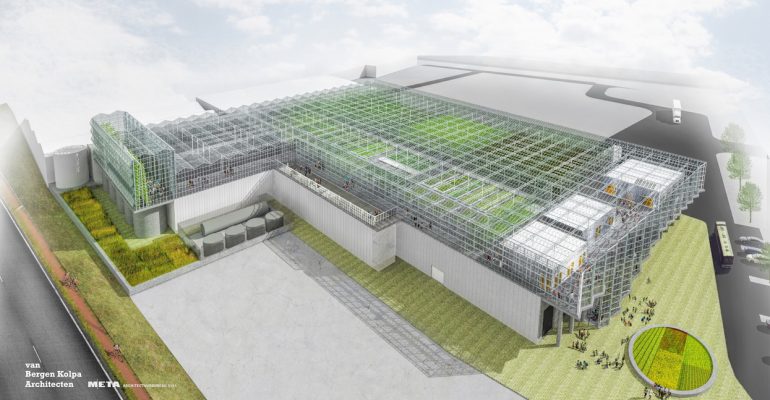For Inagro, “the scope of research must meet the needs of the farmers”
Inagro’s applied research facility in Roeselare, West Flanders, can be imagined like a tree: it consists of many branches, spanning technical crop departments, knowledge centers, laboratories and a Society & Environment department. I spoke with employees from three different departments to get a sense of the scale and variety of projects that are being tackled under a single organizational roof:
- Ine Pertry, project developer for Agrotopia, the rooftop greenhouse initiative
- Stefan Teerlinck, head of Aquaculture and Insect Cultivation
- David Deruytter, of the Insect Cultivation team
The impression I got is best summed up by Ms. Pertry herself, who told me that Inagro is:
“An inspiring environment, very interactive. Because we are all under one roof, we can collaborate with other departments as we look for new innovations to improve conditions for growers and farmers.”
All of the departments stressed that their method is based upon applied-research: research projects are first selected by technical advisory boards on the basis of direct feedback from farmers. They are then able to involve farmers in the projects and set up regional hubs and networks that validate the results of their research. Having highlighted the rooftop greenhouse initiative last week, let’s take a look at a few more departments within Inagro.
Applied Research in Aquaculture
I spoke to Stefan Teerlinck who, as head of aquaculture operations, is responsible for a 1000m2 facility with eight recirculation systems. Their research is focused around the pike-perch, a freshwater species that forms a staple in many European diets. As a standard for aquaculture research and practices in the West Flanders region, Stefan’s team has two overarching goals:
- Providing advice and guidance to people who want to get involved in freshwater aquaculture. These could be students, investors or institutes.
- Applied research on improving the sustainability of pike-perch production.
Inagro’s small aquaculture outfit is constantly working to improve practices in brood stock management, selection, growth and quality within the construct of recirculation systems. With exhaustive research and applied practices, they are improving the economics of sustainable fish farming.
Stefan stressed the importance of their knowledge being transferred to the end consumer. To that end, anyone who is interested in the industry can go to Inagro and work one month for free, gaining access to all the expertise the facility and its team has to offer. A final facet of the aquaculture team is to work toward integration with other departments; an example is the effluent water being sent to the greenhouses to be used in tomato production, and in trials for cucumbers and other vegetables.
Insect cultivation
Inagro’s insect cultivation department is closely associated with the aquaculture team, as Stefan is the head of both divisions. I spoke to David Deruytter, who is part of the team that is leading the way in pushing for insect cultivation to be adopted as an integral piece of Europe’s agricultural strategy.
They focus on processing various types of biomass from this stock and produce 40-50kg of insects on a good week . Insect cultivation is vital to closed loop agricultural systems, as it offers a way to valorize waste streams. David said that this would be the greatest opportunity for collaborating within the AVF; organizations that need guidance on what to do with waste streams can be sure to find answers at Inagro.
Solving problems through collaboration
Having so many branches of research under a single roof is a clear advantage for Inagro. Ms. Pertry says:
“At this moment, the focus is put on the constant technological innovation in the existing departments, as well as the development of cross-sectoral research activities within the scope of the circular economy. We can connect insect production with aquaculture, aquaculture with indoor cropping, valorization of biomass with mushroom production and insect production, etc.”
But the collaboration doesn’t end under that single roof. Inagro actively looks to collaborate externally, partnering with universities, university colleges and businesses in order to spread its applied research. They are active participants in many European initiatives, including seven of the Horizon 2020 projects. Collaboration is clearly on the cards within the network of AVF members. Ms. Pertry calls it:
“a good network, a wide and interesting network. We can learn a lot from the organization and its members. It is a good opportunity to make new contacts in this topic of research.”
Inagro’s upcoming projects
The AVF will certainly learn a lot from such an active and respected research institution. Inagro’s notable ongoing projects include:
- Bioboost: creating value chains in the bio-based economy; valorization of waste streams.
- Redung: developing a model for precision irrigation in greenhouses.
- Inapro: applied aquaponics research.
- Entomospeed & Entomatisation: developing production techniques in insect production systems.
- Nuredrain: valorizing nutrients out of drainage discharge and greenhouse effluents.
In the coming weeks, Broadcast Manager Jason Moon will perform an interview with Inagro for the AVFfm podcast series.
For more information on Inagro, please follow this link.
For an English brochure, click here.
Rooftop greenhouse initiative: Agrotopia (Dutch).

